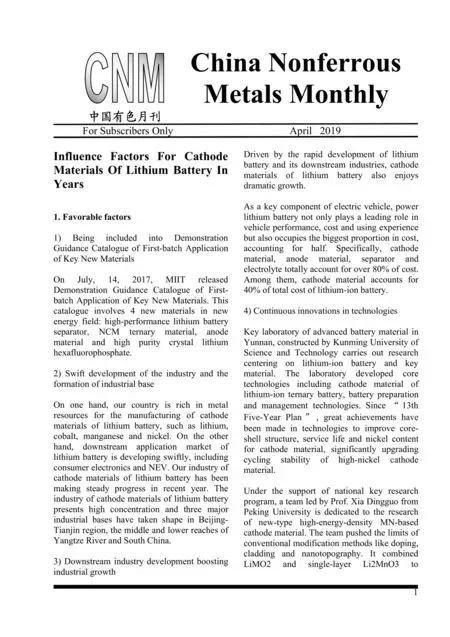Influence Factors For Cathode Materials Of Lithium Battery In Years
?
Influence Factors For Cathode Materials Of Lithium Battery In Years
1. Favorable factors
1) Being included into Demonstration Guidance Catalogue of First-batch Application of Key New Materials
On July, 14, 2017, MIIT released Demonstration Guidance Catalogue of First-batch Application of Key New Materials. This catalogue involves 4 new materials in new energy field: high-performance lithium battery separator, NCM ternary material, anode material and high purity crystal lithium hexafluorophosphate.
2) Swift development of the industry and the formation of industrial base
On one hand, our country is rich in metal resources for the manufacturing of cathode materials of lithium battery, such as lithium, cobalt, manganese and nickel. On the other hand, downstream application market of lithium battery is developing swiftly, including consumer electronics and NEV. Our industry of cathode materials of lithium battery has been making steady progress in recent year. The industry of cathode materials of lithium battery presents high concentration and three major industrial bases have taken shape in Beijing-Tianjin region, the middle and lower reaches of Yangtze River and South China.
3) Downstream industry development boosting industrial growth
Driven by the rapid development of lithium battery and its downstream industries, cathode materials of lithium battery also enjoys dramatic growth.
As a key component of electric vehicle, power lithium battery not only plays a leading role in vehicle performance, cost and using experience but also occupies the biggest proportion in cost, accounting for half. Specifically, cathode material, anode material, separator and electrolyte totally account for over 80% of cost. Among them, cathode material accounts for 40% of total cost of lithium-ion battery.
4) Continuous innovations in technologies
Key laboratory of advanced battery material in Yunnan, constructed by Kunming University of Science and Technology carries out research centering on lithium-ion battery and key material. The laboratory developed core technologies including cathode material of lithium-ion ternary battery, battery preparation and management technologies. Since “13th Five-Year Plan”, great achievements have been made in technologies to improve core-shell structure, service life and nickel content for cathode material, significantly upgrading cycling stability of high-nickel cathode material.
Under the support of national key research program, a team led by Prof. Xia Dingguo from Peking University is dedicated to the research of new-type high-energy-density MN-based cathode material. The team pushed the limits of conventional modification methods like doping, cladding and nanotopography. It combined LiMO2 and single-layer Li2MnO3 to manufacture O2-configuration MN-based lithium-rich battery cathode material. This type of cathode material has discharge capacity of over 400mAh/g and specific energy density of over 1380Wh/kg, creating big possibilities to develop new-type lithium-ion battery with specific energy density of over 500Wh/kg, being the MN-based lithium-rich cathode material of lithium-ion battery with the highest specific energy density so far reported in the world. The team provides new inspiration for future research of new-type high specific energy density lithium-ion battery cathode material and broke restrictions of layer-structure MN-based lithium-rich material patent (O3 configuration) in foreign countries.
2. Adverse factors
Excessive low-end products and insufficient high-end products
In our country, capacity of cathode materials concentrates in low-end products while capacity in high-end products (like high-performance ternary materials) is far from sufficient. Therefore, lithium battery cathode material industry currently is in the stage of oversupply. Driving force for this industry in the coming years relies on demand growth of power battery. Meanwhile, in product distribution, we have excessive low-end capacity and insufficient high-end capacity.
Still falling behind advanced enterprises in Japan and Korea
Internationally renowned advanced cathode material enterprises are mainly in Japan, China and Korea. Cathode material enterprises in other countries are small in scale and simple in product type. Therefore, the aforesaid three countries are recognized as three giants in global cathode material industry. Japan and Korea have longer history of industrial development. They have been dedicated to developing high-end cathode material like ternary material for long. While in China, due to various factors, this industry has put its emphasis on lithium iron phosphate in the past. With the development of NEV industry, our country and enterprises have gradually come to attach importance to ternary material. However, we still fall behind advanced enterprises in Japan and Korea in technologies.
3. Risk of substitution
Upgrading is very swift in cathode material of lithium battery industry and requirement for performance is even raised higher and higher. Furthermore, alternative technologies such as fuel cell, lithium-sulfur battery and lithium-air battery are likely to substitute for current products if a technology reform takes place, although they still need time to achieve mass production.
 China Nonferrous Metals Monthly2019年4期
China Nonferrous Metals Monthly2019年4期
- China Nonferrous Metals Monthly的其它文章
- Zinc Production by Province in 2019
- Technical and Economic Indicators of Major Enterprise
- Copper Mine Production by Province or City in 2019
- Lead Production by Province or City in 2019
- Fabricated Copper Production by Province or City in 2019
- Production of the Ten Major Nonferrous Metals in 2019
